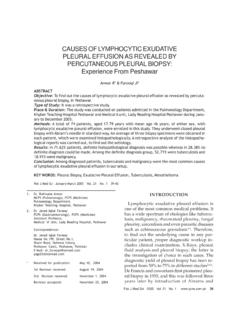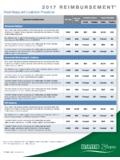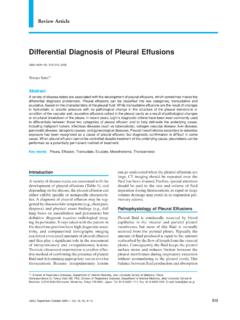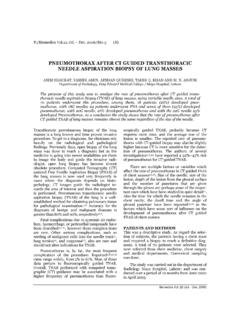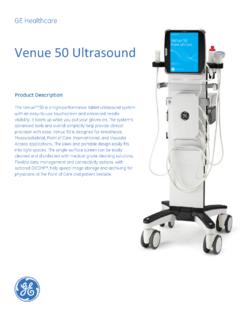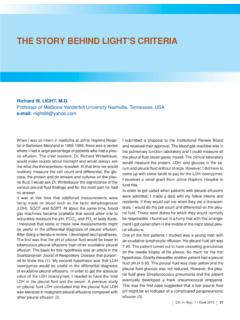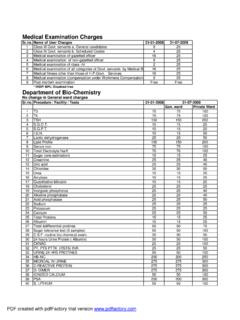Transcription of Chylothorax: diagnostic approach Vasileios …
1 chylothorax : diagnostic approachVasileios Skourasaand Ioannis KalomenidisbIntroductionChylothorax or chylous pleural effusion (CPE) is definedas a pleural effusion containing chyle. The presence ofchyle in the pleural space is usually due to thoracic ductdisruption. Clinically, chylothorax usually presents withprogressive breathlessness of acute or subacute thoracentesis usually results in the aspirationof a milky lymphocyte-predominant exudative fluid. Diag-nosis is confirmed when pleural fluid is found to containchylomicrons or when the pleural fluid triglyceride levelsexceed 110mg/dl [1 3]. However, most clinicians wouldorder these tests only in patients with milky or turbideffusions.
2 Are there any other clinical conditions in whichpleural fluid lipid analysis could be indicated even innonmilky effusions? Should the practitioner considerthe possibility of chylothorax in any group of patientspresenting with transudative or neutrophil-predominantpleural effusion? In the present article we try to addressthese questions based on recently reported clinical obser-vations and we attempt to provide a comprehensive diag-nostic approach for patients with suspected and physiologyDietary triglycerides are degraded in the small intestineinto free fatty acids which diffuse into the intestinal cellsafter a number of assimilation processes. Long-chain fattyacids (>12 carbons) incorporated into triglycerides com-bine with cholester-esters, retinyl-esters, phospholipidsand cholesterol to form chylomicrons, which leave theintestine in the lymph channels that terminate in thecisterna chyli.
3 The cisterna chyli contains a bacteriostatic,nonirritating, milky fluid called chyle which is charac-terized by T-lymphocyte predominance, protein con-centration of , high triglyceride levels(>110mg/dl) and cholesterol levels (65 220mg/dl) lowerthan those of serum [1,4 7].Arising from the cisterna chyli at the level of the L2vertebrae, the thoracic duct enters the chest cavitythrough the esophageal hiatus and ascends extrapleurallyin the posterior mediastinum, along the right surface ofthe vertebral column. At the carina, it crosses to the leftof the vertebral column and continues cephalad. AfteraChest Physician, 412 Military Hospital, Xanthi andbLecturer, 2nd Department of Pulmonary Medicine,Athens Medical School, Atticon Hospital, Haidari,GreeceCorrespondence to Ioannis Kalomenidis, MD, 2ndDepartment of Pulmonary Medicine, Athens MedicalSchool, Atticon" Hospital, Haidari, GreeceTel: +302105831152; e-mail: Opinion in Pulmonary Medicine2010,16:387 393 Purpose of reviewThis review evaluates recent research findings and proposes an up-to-date diagnosticapproach for patients with suspected findingsTypically, chylothorax is a milky exudate with high triglyceride content (>110mg/dl).
4 However, milky appearance is not always the case and triglyceride levels can be lessthan 110mg/dl, especially in fasting or malnourished patients. Transudativechylothoraces have been reported when cirrhosis, nephrosis or heart failure co-exist. Inaddition, although the vast majority of the white blood cells in chyle are lymphocytes,chylothoraces can be neutrophilic, especially the postsurgical is the accumulation of chyle into the pleural cavity usually due to thoracicduct leak and should be suspected not only in patients with milky effusions but also inthe presence of certain co-morbidities or history of chest/neck trauma. Fluidtriglycerides more than 110mg/dl or less than 50mg/dl virtually establish or excludethe diagnosis, respectively; ambiguous cases with values 50 110mg/dl requirelipoprotein analysis for the demonstration of chylomicrons.
5 In fasting or malnourishedpatients lipoprotein analysis is suggested even with triglycerides less than 50 pleural fluid in chylothorax is a lymphocytic exudate with low lactatedehydrogenase; atypical fluid characteristics ( transudative nature, neutrophil-predominance or high lactate dehydrogenase) may be a sign of additional causes ofpleural fluid , chylous, triglyceridesCurr Opin Pulm Med 16:387 393 2010 Wolters Kluwer Health | Lippincott Williams & Wilkins1070-52871070-5287 2010 Wolters Kluwer Health | Lippincott Williams & the mediastinum, it arches above the clavicle anddescends anterior to the subclavian artery to terminate inthe junction of the left internal jugular and left subclavianveins.
6 This anatomic pattern is present in approximately50% of individuals, whereas wide anatomic variationsexist in the remainder [1,2,8 10].Etiology and pathogenesisThe accumulation of chyle in the pleural cavity may bedue to rupture of the thoracic duct and/or its tributaries,leakage from the pleural lymphatics and/or collateralvessels, or transdiaphragmatic flow of chyle from theperitoneal cavity in patients with chylous ascites. Themain pathogenetic mechanisms of chyle leak are inter-ruption of lymphatic wall integrity due to direct injury,straining or infiltration by abnormal tissue, and lymphvessel rupture due to elevated intraluminal pressure asa result of obstruction, increased intraluminal lymphvolume, abnormal lymphatic lumen or increased venouspressure [10 23].
7 Situations evoking any of these mech-anisms represent chylothorax causes (Table 1), which aregrouped into four major categories: trauma, malignancy,miscellaneous and idiopathic [1].Trauma of the large supra-diaphragmatic lymphatics isthe most common cause of chylothorax , accounting forapproximately 50% of cases [15,24 ]. Iatrogenic traumaof thoracic duct and/or its tributaries results from surgicaland minimally invasive procedures to the chest or any chest or neck intervention (Table 1) canresult in lymph vessel injury, esophagectomy is theoperation most commonly complicated with chylothorax [15,19,24 ,25 ,26 31]. Other interventions, such as cen-tral venous catheter placement, tube thoracostomy, pace-maker implantation, pulmonary artery embolization andthoracic irradiation, are responsible for approximately 5%of chylothoraces [15].
8 Penetrating or blunt thoracictrauma, weight lifting, straining, coughing, vomiting,yawning, seat belt injury and childbirth are the mainnoniatrogenic causes of lymphatic injury [32 37]. Malig-nancy is the underlying cause in approximately 30% ofchylothoraces, representing the second most frequentcause [1,15,24 ,38,39]. Because lymphoma accountsfor 70 75% of the malignancy-associated chylous pleuraleffusions, it should be always considered in chylothoracesthat cannot be attributed to another obvious cause[1,15,40]. The miscellaneous category includes a varietyof diseases (Table 1) that can cause chylothorax bydiverse pathogenetic mechanisms [15,21,24 ,41 48].
9 Ifno cause is identified, chylothorax is termed approachThe diagnostic approach of chylothorax (Fig. 1) consistsof three sequential steps: first, one should suspect thediagnosis, second the presence of chyle in the pleuralcavity should be verified and third, the underlyingabnormality should be suspicionChylothorax is certainly suspected when milky fluid isaspirated. However, for reasons discussed below, thisdiagnosis could also be considered in patients withpleural effusions even when the fluid is nonmilky ifcertain diseases commonly associated with chylothoraxare present, especially, but not exclusively, in fasting ormalnourished history and clinical presentationThe diseases reported to cause chylothorax are numerous(Table 1).
10 Some specific morbidities though, such asrecent chest or neck intervention, malignancy, superiorvena cava or subclavian vein thrombosis, liver cirrhosisand lymphatic disorders, are more frequently related andshould alert the clinician for the possibility of chylothorax [1,10 21,24 ,25 ,26,32,35,38,41,42,49 ]. Symptoms ofchylothorax namely dyspnea, nonproductive cough andchest discomfort are similar to that of pleural effusions ofother etiologies and, therefore, are not really useful in thediagnostic approach . Typically, chylothorax is not accom-panied by pleuritic chest pain and fever, as chyle does notcause pleural inflammation [1,2,38]. pleural fluid appearanceAlthough chylothorax has been traditionally linked to theaspiration of a white, odorless, milky fluid, this is notalways the case [1,3].

